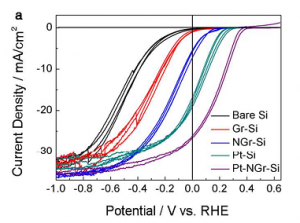Researchers have demonstrated the use of doped graphene to improve the photoelectrochemical production of hydrogen.
In a novel approach, a monolayer of graphene has been reported as an effective catalyst towards the hydrogen evolution reaction (HER). By depositing a single layer of graphene on a p-doped silicon photocathode, the overpotential required for the HER in the presence of light was shifted positively by 0.18 V vs. RHE. The catalytic activity was confirmed to be a result of the graphene layer by testing on a glassy carbon substrate, where a 50 mV shift in onset compared to glassy carbon baseline was discovered.

This transparent catalyst monolayer was also shown to act as a passivation layer, preventing oxidation of the substrate while maintaining current density. This led to a more consistent onset potential when compared to the bare Si photocathode, which degraded over time quite substantially. Furthermore, by treating the graphene layer in nitrogen plasma, the added defects, as well as the nitrogen doping, led to even further improvements in catalytic activity towards HER.
As a proof of concept, platinum was added to the N-doped graphene monolayer, where a solar-to-hydrogen conversion efficiency of 3.05% was reported, which maintained activity over a range of pH. With further optimizations, carbon based catalysts can contend as a cost effective method for the clean production of hydrogen on a commercial scale.
Interested? Read the full communication in Energy and Environmental Science here:
N-doped monolayer graphene catalyst on silicon photocathode for hydrogen production
Uk Sim, Tae-Youl Yang, Joonhee Moon, Junghyun An, Jinyeon Hwang, Jung-Hye Seo, Jouhahn Lee, Kye Yeop Kim, Joohee Lee, Seungwu Han, Byung Hee Hong and Ki Tae Nam
Energy Environ. Sci., 2013, Paper
DOI: 10.1039/C3EE42106F










